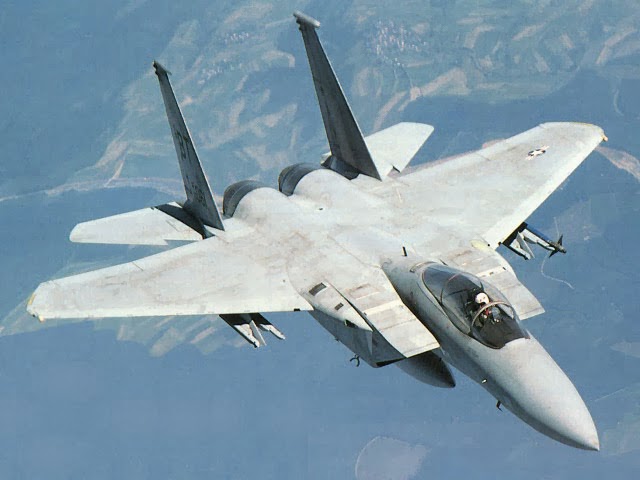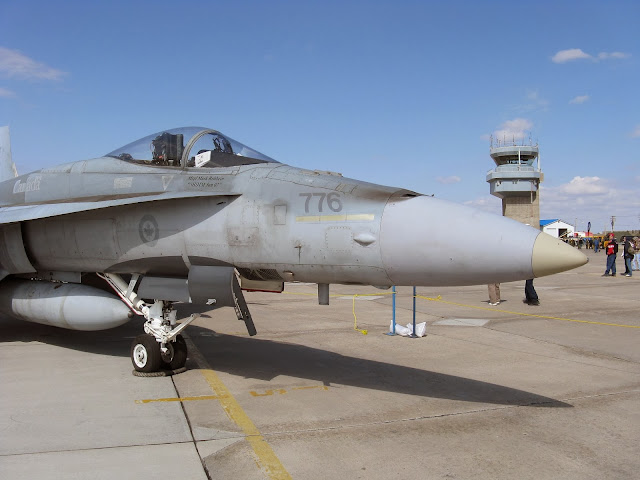Revisionist history... Should we have bought the CF-18?
Canada's "new fighter aircraft" (NFA) was developed to find a single airframe to replace both the CF-101B used for interceptor duties and the CF-104 used for ground attack (despite the F-104's intended use as an interceptor) and nuclear deterrence in Western Europe. 138 aircraft were planned, with provisions to order more if needed. Plans to replace the CF-116 (CF-5) Freedom Fighter with the same aircraft was postponed indefinitely.
 |
| Panavia Tornados in CFB Goose Bay. |
In 1965, Canada had joined up with Germany, Italy, Belgium, and the Netherlands to develop a "multi-role combat aircraft for 1975" (MRCA-75). In 1968, the U.K. joined the party. The MRCA-75 would later become the strike fighter known as the Panavia Tornado. Canada left the program in the early stages, however. This was a political move based on concerns that the bulk of the Tornado's manufacturing and development would take place in Europe, not Canada.
In retrospect, the Tornado wasn't a great fit for Canada, anyway. Developed primarily as a strike aircraft, the Tornado wasn't the best choice for interception duties. A newer variant, the ADV, was developed as a dedicated interceptor, but it still lacked the agility of air-superiority fighters like the F-15 Eagle. It was also a rather complicated aircraft requiring two crew members to fly. Even if Canada bought both versions of the Tornado, it would still not have a decent dogfighter.
 |
| Panavia Tornado |
 |
| Dassault Mirage 2000 |
 |
| Grumman F-14 Tomcat |
 |
| McDonnell Douglas F-15 Eagle |
 |
| General Dynamics F-16 Fighting Falcon |
 |
| McDonnell Douglas CF-18 Hornet |
Thankfully, this being the mid-70s, there were plenty of other aircraft to choose from. Lessons learned during the Vietnam War placed a much higher emphasis on dogfighting ability, and the period was somewhat of a renaissance for fighter aircraft. There was the F-14 Tomcat, F-15 Eagle, F-16 Fighting Falcon, and the F/A-18 Hornet. The Dassault Mirage 2000 was also considered, but quickly disqualified since it was not yet fully developed.
 |
| So close... |
The F-14 was eliminated due to its cost and lack of strike capability. Even so, Canada did come close to acquiring the Tomcat it what could have been a "deal of the century". After the "Islamic Revolution" of 1979, Iran could no longer get parts for its fleet of F-14s bought by the Shah. Unable to maintain its fleet, Iran came close to selling the F-14s to Canada at an extreme discount. The deal went south when Canada was found to be assisting U.S. Embassy hostages escape.
Like the F-14, the F-15A was a very impressive interceptor and dogfighter. It was also severely lacking when it comes to ground attack ability and was incredibly expensive to purchase and fly. Buying 138 F-15 would have seriously broken the bank, and Canada would still need some type of ground attack aircraft to fill the gap, possibly the A-4 Skyhawk, which had proven itself to be a very cost effective platform.
Despite its lack of strike capability and its high costs, the F-15 may have been a great fit for Canada. Its long range, high speed, and powerful radar make it a fantastic interceptor. Over the years, the F-15 has proven itself to be one of the best fighters of all time, achieving 104 combat kills with 0 losses.
The F-15 has also proven to be incredibly versatile. The F-15C variant has a not-well-known of ground attack ability, able to carry "dumb" and GPS guided bombs. The F-15E Strike Eagle is now the yardstick that all other multirole fighters are judged by. The aircraft has proven to be very "upgradable" with legacy models being retrofitted with IRST and AESA radars. Not only that, but the airframe itself has proven to be incredibly durable, with F-15C/D models possibly flying up to 18,000 hours, and F-15E models flying up to an amazing 32,000 hours. To put this in perspective, the F/A-18 that Canada's CF-18 is built from was originally rated at 6,000 hours, as is the Eurofighter Typhoon. Most modern fighters, like the F-35 and F-18E/F Super Hornet are rated for 8,000. It is very likely, had Canada chosen the F-15 over the F/A-18, we would merely be looking at a simple life extension program, instead of shopping for a new fighter fleet.
What about costs? The F-15 was significantly more expensive than the F/A-18 or F-16. It's also a very expensive aircraft to maintain. This could have been remedied by a simple solution. Buy less.
As it was, Canada ordered 138 CF-18s. Of those 138, only 79 (57%) remain in service. 18 have been lost due to crashes. In 2001, only 80 CF-18s were upgraded to the current F/A-18C/D standard. Within 30 years, over 40% of Canada's F-18 fleet was put to pasture, a horrible attrition rate to say the least.
Alternatively, if Canada had bought a smaller number, say 60-80 F-15s, the costs involved in maintaining a smaller number of more expensive aircraft would likely be similar to that spent on the CF-18. In order to supplement these lower numbers, Canada could make use of a fighter that already existed in its inventory; the CF-116 Freedom Fighter (CF-5).
Canada operated the simple, low cost, Canadian made CF-5 from 1968 to 1995. It was retired from service more or less due to its overlap with the CF-18. Many nations (like Switzerland and S. Korea) still fly the F-5 however, and are only now looking at replacing them. While the F-5 is completely outclassed by just about any modern fighter, it does well enough in light ground attack, pilot training, and other light duties. A mixed fleet of F-15Cs supplemented by CF-5s would have been an effective combination. It would also have the advantage of longevity, with the "CF-15s" likely able to get by with an upgrade program (AESA radars, IRST, etc) and the CF-5s getting replaced by another low cost airframe, like the BAE Hawk, Saab Gripen C/D, or even the F-16.
But Canada didn't go that way.
 |
| Modern day F-16 |
Like the F-15, the F-16 Fighting Falcon is a serious dogfighting machine. Unlike the F-15, the F-16 is cheap. Since it was so simple and cheap, the F-16 found itself being produced in incredibly large numbers, with those economies of scale making it even cheaper. Initially intended as a short range day fighter, the F-16 would go on to become a proverbial workhorse, outfitted with countless varieties of weapons for either the air-superiority or the ground attack role.
The F-16 shares the F-15's expandability. Modern versions are fitted with advanced targeting pods, conformal fuel tanks, and some are even being retrofitted with AESA radars. With its affordable cost and slew of continuous updates, the F-16 has become the ubiquitous western fighter aircraft of modern times.
So why didn't Canada choose the cheaper F-16 over the F-18? At the time, the then current F-16A was a little too simple. Its basic targeting radar meant that only short range Sidewinder missiles could be mounted. Longer range missiles, like the AIM-7 Sparrow, would have to wait for the improvements made with the F-16C. The F-16 was also powered by single engine, a liability to an RCAF still reeling from the CF-104's horrendous (and possibly undeserved) safety record. There is a rumor that the RCAF demanded a twin-engine fighter more as an excuse to select the more expensive F-14 or F-15, rather than any real concern over the F-16's safety. In retrospect, the single-engine F-16 has had a better safety record than the F/A-18.
 |
| F-18L mockup. |
Even the choice to go with the truly multi-role, most advanced (at the time), affordable, twin engine fighter wasn't completely cut and dry for the RCAF. Two versions of the F-18 Hornet was being offered; the McDonnell Douglas F/A-18A and the Northrop F-18L.
When McDonnell Douglas adopted the YF-17 Cobra's design into the carrier based F/A-18 Hornet, part of the deal was that Northrop would get to market a land-based version of the design, the F-18L. With no need for a heavy-duty landing gear, folding wings, and other equipment needed for carrier-based duty; the F-18L would have been lighter, faster, more agile, longer ranged, and likely cheaper than the F/A-18A.
The F-18L even offered the most lucrative industrial benefits. Wings and tails specific the the F-18L would be built in Canada, and widespread adoption of the platform would mean a good return on the investment. This reward came with a fair amount of risk, however, as the F-18L was still in the planning stages and had as yet received any orders. The risk was considered too great and the "off-the-shelf" F/A-18 was selected instead.
 |
| CF-18A intercepts a Tu-95 "Bear". |
All this "Monday morning quarterbacking" is all well and good, but, in the end, the CF-18 has served Canada respectably. It has fought in 3 air campaigns (Iraq, Bosnia, and Libya) without a single combat loss. It has policed Canada's airspace and intercepted countless Soviet (and Russian) bombers.
Over the years, the CF-18 has had very little controversy. This cannot be said about its immediate predecessors. The CF-101 was a nuclear armed "consolation prize" that the RCAF got instead of the Avro Arrow. The CF-104, on the other hand, was a low-altitude strike fighter based on a high-altitude interceptor design. Needless to say, forcing a high-altitude interceptor to act like a bomber caused a few problems, earning it the nickname "Widowmaker".
Thankfully, the CF-18 will be an aircraft remembered with fondness, rather than derision. It may not have been the best, but it has been a damn good aircraft.





That's a very interesting look at the past. And past often explains present decisions.
ReplyDeleteThere are many interesting details. For example, the fact that Tornado was only intended as a bomber, to replace only F104G, is linked to the fact that UK and Germany had air superiority F-4 (later replaced in this role by... the Typhoon!). You wanted also a good dog-fighter to replace CF-101, so Tornado wasn't for you.
But, what was the initial configuration of CF-188? With which weapons? I guess laser-guided bombs and AMRAAM were added in the 2001 Mid-Life Upgrade. As a derived version of F/A-18A, I think we should not confused the first CF-188 with the post-2001 version...
Mirage 2000 would have been a good option, but the single engine configuration wasn't good for Canada... and finally even for France : whatever the engine reliability, if a bird fly in the air intake, that's over. So, 2 engines seem preferred now. Still, what a dogfighter you would have had! However, I don't understand why it could have been rejected because being not fully developped : Mirage 2000 made its first flight before F/A-18A and entered active service just one year after F/A-18A (1984 vs 1983).
I share your conclusion : even at the time, CF-188 seems a rather good solution. With a little more ambition, F-18L was probably the only better option.
The CF-188 originally came equipped to use AIM-9 Sidewinders, AIM-7 Sparrows (AMRAAMs would come later), "dumb" bombs, AGM-65 Maverick missiles, rocket pods, and a few others if memory serves me. It actually had a pretty good array of weapons for the time, as the F-16 didn't get its wider variety of weapons until the "C" model. The F/A-18's low speed handling makes it better in the close-air support role as well.
ReplyDeleteI have the feeling that the Mirage was more or less dismissed for the same reason the Rafale will be passed over this time... Politics.
ok, thanks for the details. That seems indeed very good for the time.
ReplyDeleteFor this particular case politics and operational requirements were compatible... not exactly true today!
I think 70 F-15C Eagles would have been okay
ReplyDeletePlus 40 CF-18s would make a decent fleet of fighters